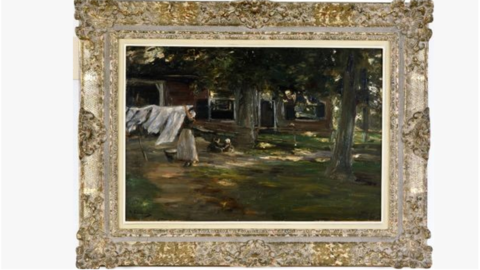Max Liebermann’s painting At the Washhouse has been in the collection of the Hesse State Museum Darmstadt since 1962. It was acquired at the 37th auction in Roman Ketterer’s Stuttgart Art Cabinet on 3/4 May 1962 by the Hesse Ministry for Schools and National Education, in order to fill gaps in the museum’s collection, caused by the confiscation and sale of art works by the National Socialists. Only in 2017 did the painting become the property of the museum.
The Hesse State Museum Darmstadt had previously acquired two paintings by Liebermann, in 1924 and 1927. The first purchase was a genre painting of a garden scene, “Child with Nurse”, created in 1923, that probably showed Liebermann’s granddaughter with her nanny. Its current location is unknown. The second painting was a self-portrait of Liebermann purchased directly from him. The location of this work is likewise unknown. When these two paintings were resold by the museum during the National Socialist era can no longer be determined since the museum’s records were entirely destroyed in an air raid on 11/12 September 1944.
The painting At the Washhouse was at least since 1927, though possibly since 1907, in the collection of the Frankfurt court jeweller Louis Koch (1862– 1930). The inscription on the reverse, “K 126,” refers possibly to an inventory of his collection. Koch’s two daughters inherited his extensive collection of art, antiques, and autographs, at the latest after the death of their mother Alice, neé Flersheim, in 1936. Because they were Jewish, both Martha—whose second husband was the art collector Robert von Hirsch—and Maria were subjected to persecution by the National Socialists. Maria Koch (1895– 1955) had in 1920 married the agricultural economist Rudolf Flörsheim (1893– 1962) and had lived with him since 1921 on the Bayers-Eich estate near Egelsbach. Rudolf Flörsheim’s Jewish origin meant that he too was persecuted by the National Socialists. In 1936, the couple decided to sell the estate and emigrate to Florence with their two children. After the situation there became increasingly threatening— Rudolf Flörsheim was arrested during Hitler’s state visit to Italy in 1938—they fled to Switzerland. Whether they took the painting with them on their flight, or whether they had already sent it on ahead, cannot be determined. The painting was displayed at the big Liebermann exhibition in 1948 in the St. Gallen Art Association as item No. 29. But who owned it at that time? Had the Flörsheims had to sell it between 1938 and 1945, because as immigrants to Switzerland they were denied a work permit and were thus short of money?
The records of the exhibition have fortunately been preserved. They state that in 1948 “Maria Floersheim-Koch, Wildegg” was the painting’s owner. The suspicion that the painting might be goods confiscated by the National Socialists or fugitive goods has thus not been confirmed.
Udo Felbinger
